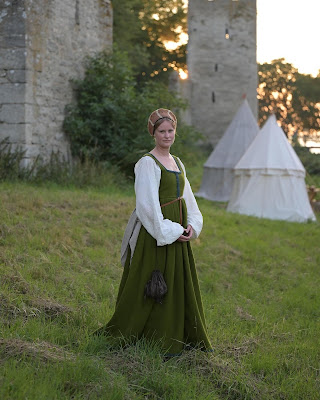The week, the one and only week, the Medievalweek in Visby. The highlight of the year. And it is over! But the memories are still there. Every time I go home from that week I think about all of those who only have that week, who dont do anything medieval for the rest of the year. And that breaks my heart a little, imagine to only have one week a year to do the best thing in the world. What a horrible thought! My next event is a market in two weeks and a tournament in three. Anyhow...
The week was a little bit different for me though. I stayed with my tent in a new camp. And they took such good care of me. Made me feel like one of them from the start. The camp was open for tourists during the day, with activities for them to try. I was sewing the entire time, making a pair of pants for a friend. What I do every day anyway, right!
I brought my new tent this time. I bought it as a market-tent but after realizing it was waterproof I thought, better safe than sorry. Last medievalweek was so wet and windy that it was more a question about surviving than anything else. And I didnt feel like doing that again. And I had only used it ones, for a market in july, so I thought I needed to try it with all my furniture. Could have been done better... next time! But I did have new curtains to hide modern stuff behind and it look quite cosy like this, doesn't it?!
And this is the main part of camp. During medieval week in Visby there are a couple of small camps and the big medieval/SCA-camp where I have stayed before. In the big camp anyone can stay but in this small one you need an invite to join. I think we where about 40 people in it this year.
Nancy took this one too. This dress where made for medieval week. Or at least finished in time for it. My thought with this dress is to represent a kirtle for a wealthier city dweller or maybe even low nobility. I wanted something to wear when it was nice weather that I could wear my sca jewellery with. It does not feel proper to wear jewellery with my farmers outfit for example. Im wearing my new green kirtle with a white shirt and a silk hairnet.
This is the same outfit, but with my Schurz, an apron surrounding the whole skirt. Two examples of this kind of apron can be seen in a painting by Hans Wertinger, The Labors of the month, from 1525. One woman in the painting is actually wearing it like this, on top of a sleeveless kirtle. She is also wearing a white shirt underneath.
This photo is take by Sarah Rosenquist.
And, at last, my favorite, the farmers outfit. This is probably the outfit I feel most like myself in. You cant really see but Im wearing a kirtle in undyed wool on top of an undyed shirt. On top of the kirtle Im wearing the same apron, the schurz, and a gollar in linen. I need to make more undyed shirts. It would not be proper to have a white shirt with this clothing. Is undyed the right word? Unbleached? Not white, you get it. I only have two, and that wont work for a week in the middle of summer. I did not, however, by any more linen, what was I thinking?! Well, the long events are done for the year, only weekend-events left. But for next year!
Sarah took this photo too. The city wall in the background is just magical.






























